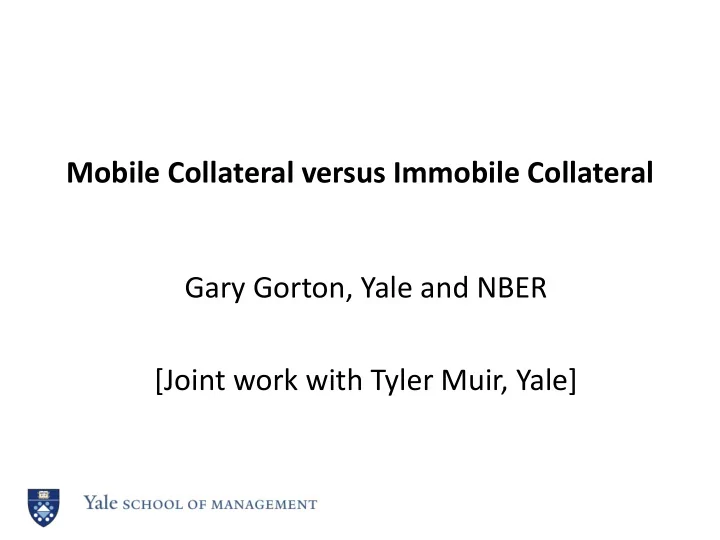

Mobile Collateral versus Immobile Collateral Gary Gorton, Yale and NBER [Joint work with Tyler Muir, Yale]
The Transformation of the Financial System • Over the last 30 years prior to the crisis, the architecture of the financial system changed. • Thirty years ago the system was one of immobile collateral . – Bank loans stayed on bank balance sheets to back demand deposits. • The world changed: other forms of money arose: repo, ABCP. Needed collateral. • Not enough Treasuries so the private sector produced “safe debt”— RMBS, ABS.
Components of Privately-Produced Safe Debt as a Fraction of Total Privately-Produced Safe Debt (U.S.) 100% 90% 80% 70% 60% Shadow 50% Banking 40% 30% 20% Traditional Banking 10% 0% 1952Q1 1957Q1 1962Q1 1967Q1 1972Q1 1977Q1 1982Q1 1987Q1 1992Q1 1997Q1 2002Q1 2007Q1 Deposits Money-like debt MBS/ABS Debt Corporate Bonds and Loans Other Liabilities
The Financial Crisis Regulatory Aftermath • New money vulnerable to runs. • Since the financial crisis, “reform” has aimed to return to the system of immobile collateral . – Must post collateral to CCPs, but CCPs do not post back. – On-balance sheet derivatives require collateral, and it cannot be rehypothecated. – The LCR requires essentially that all repo be backed dollar for dollar with Treasuries — a kind of narrow banking. One kind of money backs another kind of money.
Treasuries have a Convenience Yield Source: Krishnamurthy and Vissing-Jorgensen JPE 2012
Lucas Critique • How do we assess proposed new policies? • Unintended consequences?
Ratio of Notes to Deposits and Treasury Debt to GDP Correlation = 0.96
Demand Deposits not Understood • Bray Hammond (1957), in his Pulitzer Prize-winning book Banks and Politics in America , wrote: “. . . the importance of deposits was not realized by most American economists . . . till after 1900” (p. 80). • Russell C. Leffingwell, the Assistant Secretary of the Treasury wrote as late as 1919: “All of these people who believe in the quantity theory of money . . . choose to call bank deposits money, but bank deposits are not money.”
Conclusions • Design of Nat’l Banking System led to the rise of demand deposits —”shadow banking.” • Five major banking panics. • Same problems now: – Unintended consequences – Conceptual issues
“Those who ignore history are entitled to repeat it.”
Recommend
More recommend